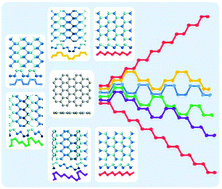Highly stable phosphorene isomers based on a buckled honeycomb lattice†
Abstract
Due to their high stabilities and tuneable electronic structures, two dimensional isomers of black phosphorene (BP) have drawn great attention recently. By carefully considering the bonding characteristics of phosphorus atoms, we propose a buckled honeycomb lattice strategy to search for possible highly stable phosphorene isomers. As an example, phosphorene isomers with a unit cell size no larger than 8 atoms are fully explored and 14 isomers, including the well-known α-, β-, γ-, δ-, and ε-phosphorene, are discovered and named from P-I to P-XIV in the order of their relative stabilities. Among these isomers, P-II and P-III are two newly found isomers with superior stability comparable to BP, whose formation energies are just 0.01 and 0.03 eV per atom higher than that of BP (α-phosphorene), respectively, and both are more stable than the well-known blue phosphorene (β-phosphorene). These new phosphorene isomers exhibit a wide range of medium energy band gaps from 0.30 to 2.66 eV, various HOMO/LUMO energy levels and, therefore, can be used for various optoelectronic and device applications.



 Please wait while we load your content...
Please wait while we load your content...